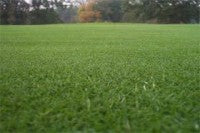Trace elements are the key to success
TRACE ELEMENTS ARE THE KEY TO HEALTHY TURF
By John Wanklyn
The deserts are made of sand because that is all that remains of the soil after desertification. The arid climate and the extremes of temperature have removed the organic matter and most of the trillions of soil-based bugs can no longer survive these conditions. A few opportunist plants and animals lie dormant, waiting for the opportunity to complete their life cycles in the brief aftermath of a desert rainstorm and they are as much as the desert can now support. Sand is after all a very infertile growing medium.

Trace elements are every bit as vital as the major nutrients. If your pitch is zinc deficient there will be 100 poor plant enzymes, which all need zinc. Both magnesium and copper are needed for chlorophyll production, so without them you are in trouble. Boron, molybdenum, calcium, manganese and many other elements have multiple and complex roles to play in the growing medium, both individually and in concert. This is really the point; it is useless to concentrate on just 4 or 5 nutrient minerals, we need all of them, some feed the plant, some feed the soil bugs, the microflorae, some act as co-factors or catalysts for others. Whatever their individual roles, collectively they confer health, vigour and disease resistance to the grass plant. The whole is much greater than the sum of its parts!
The fact is that the fertility and health of modern pitches are dynamically unstable and often hindered by little direct sunlight in winter. We cannot leave them alone as we could a piece of rich pasture to draw on it's own resources. Sand is free-draining by design, has few resources as nutrient retention is very poor and therefore needs regular monitoring and accurate feeding if we are to ensure healthy growth and disease resistance. If the full mineral balance is not maintained, then the intricate symbiotic relationship between the soil, mineral nutrients and micro-organisms breaks down, immunity to disease falls away and this allows pathogenic organisms to thrive. It is interesting to note that Take-All and Fusarium are extremely rare in permanent pasture, but common in intensively grown cereals where the trace element balance has been damaged by excessive use of synthetic fertilisers and chemicals. Our experience is that the chemical onslaught removes the beneficial mycorrhizal fungi (and most probably others) that colonise the root zone and into the vacuum comes the pathogen. This would explain why sand-based pitches and golf greens with high chemical inputs are so vulnerable, particularly in the early years after construction before Nature can begin to assert herself. Where the life expectancy of a pitch is short the correct balance may never be achieved.
Field Science Ltdhas a unique approach to turf nutrition. After detailed soil analysis, we supply a monthly granular dressing containing everything required to create a fertile growing medium, except fertiliser and water. Every 3 months we re-test the soil, again in great detail, and then produce the next dressing, tailored exactly to fit the new profile and so on every quarter. By this method we can build the fertility and natural immunity of the pitch and greatly reduce the need for fertiliser and chemical input. This technology rejuvenates existing pitches, reduces the time a new one takes to establish and reduces maintenance man-hours.
Field Science manufactures every dressing individually and does not use any off-the-shelf products. We act as agents for no one and can therefore give unbiased advice and opinions. If a pitch can be routinely kept in fine fettle, it will last far longer and save the club concerned a great deal of unnecessary expense. 
Darren Baldwin, Grounds Manager for Spurs, has been using Field Science dressings since April 2004 and has seen "a significant improvement" in the pitch. Darren explained "we were aware that we had deficiencies of trace elements in the root zone and when Field Science came to see us explaining that they could correct the levels, we had to try it. Their dressings have made a very significant improvement to the pitch both in terms of grass quality, disease resistance and root development. We had a black algal problem in the shade of the South stand, which has been dramatically reduced and the sward density in that area is now excellent. Overall the pitch was much improved last season and the only difference, on previous years, was that we had used Field Science dressings. We have tested the pitch independently and all the minerals and trace element levels are correct. The Field Science monthly dressings are made especially for our pitch and are now a regular part of our regime. I certainly wouldn't be without them."
Several football clubs including Premiership clubs are already using the service and enjoying excellent results. For further details and a free on-site consultation please call Field Science on 0117 985 8580 or email improve@fieldscience.co.uk
